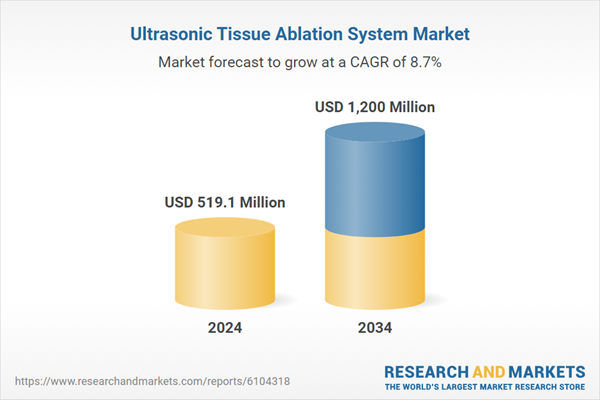Additionally, ultrasound ablation systems are being increasingly applied outside oncology for conditions like uterine fibroids, benign prostatic hyperplasia (BPH), endometriosis, and even cardiac arrhythmias, contributing to their wider clinical use. The versatility and non-invasive nature of these devices make them highly attractive for various medical specialties, further driving market growth.
Improvements in targeting precision, bolstered by real-time imaging systems like ultrasound and MRI, as well as the development of portable and automated energy modulation systems, have significantly enhanced the safety and efficacy of these procedures. These innovations have also made the devices more accessible and user-friendly, encouraging their adoption in additional healthcare settings. High-intensity focused ultrasound (HIFU) systems, which represent the largest segment in this market, continue to gain popularity due to their non-invasive approach and ability to treat sensitive areas without damaging surrounding tissue.
The high-intensity focused ultrasound (HIFU) systems segment held a major market share of USD 260.8 million in 2024, showing increasing use in delicate and sensitive areas, including the brain, prostate, and uterus. HIFU systems are now commonly used to treat cancers such as liver, kidney, and prostate, particularly in patients who are unable or unwilling to undergo surgery. In gynecology, HIFU is rapidly becoming the preferred method for treating uterine fibroids, as it offers a uterus-preserving and non-invasive approach. Additionally, it is gaining traction for the treatment of neurological disorders like Parkinson’s disease and essential tremor, especially when combined with MRI guidance.
The gynecology segment held the largest market share in 2024 and is projected to reach USD 370.6 million by 2034. This sector is experiencing robust growth driven by the rising prevalence of uterine fibroids and endometriosis among women of reproductive age. As more women seek non-invasive alternatives, high-intensity focused ultrasound (HIFU) is gaining significant traction, offering a less invasive option compared to traditional surgical methods like hysterectomy and myomectomy.
U.S. Ultrasonic Tissue Ablation System Market was valued at USD 162.3 million in 2024. Demand for these systems is rising due to favorable reimbursement policies, as well as a growing preference for minimally invasive or non-invasive procedures. The U.S. healthcare system's increasing adoption of HIFU for various indications, including prostate cancer, uterine fibroids, and neurological disorders, is driving product uptake. Integration of real-time imaging technologies is improving procedural accuracy and safety, while collaborative efforts between healthcare providers and device manufacturers are further expanding the scope of ultrasonic tissue ablation systems in the country.
Key players in the Global Ultrasonic Tissue Ablation System Market include names like FUSMobile, bioventus, BRAINSONIX, EDAP TMS, INSIGHTEC, Haifu, Söring, Verasonics, STRYKER, PROFOUND, OLYMPUS, sonablate, ASTAR, and INTEGRA. In the competitive ultrasonic tissue ablation market, companies are focusing on strategic approaches to maintain and expand their market share. Collaborations and partnerships with healthcare providers are being actively pursued to enhance clinical applications and broaden the use of ultrasonic systems. Key players are investing in continuous research and development to introduce advanced devices that integrate real-time imaging and provide more accurate treatment targeting.
Expanding their product portfolios, some companies are introducing portable versions of their ablation systems to cater to outpatient settings. Moreover, several manufacturers are focusing on improving patient comfort, reducing procedure time, and enhancing safety protocols to make their systems more appealing to healthcare professionals. Additionally, by offering training and educational programs to clinicians and healthcare providers, these companies aim to increase adoption rates and build brand loyalty.
Comprehensive Market Analysis and Forecast
- Industry trends, key growth drivers, challenges, future opportunities, and regulatory landscape
- Competitive landscape with Porter’s Five Forces and PESTEL analysis
- Market size, segmentation, and regional forecasts
- In-depth company profiles, business strategies, financial insights, and SWOT analysis
This product will be delivered within 2-4 business days.
Table of Contents
COMPANIES MENTIONED
The companies featured in this ultrasonic tissue ablation system market report include:- ASTAR
- bioventus
- BRAINSONIX
- EDAP TMS
- FUSMobile
- Haifu
- INSIGHTEC
- INTEGRA
- OLYMPUS
- PROFOUND
- sonablate
- Söring
- stryker
- THERACLION
- Verasonics
Table Information
| Report Attribute | Details |
|---|---|
| No. of Pages | 135 |
| Published | June 2025 |
| Forecast Period | 2024 - 2034 |
| Estimated Market Value ( USD | $ 519.1 Million |
| Forecasted Market Value ( USD | $ 1200 Million |
| Compound Annual Growth Rate | 8.7% |
| Regions Covered | Global |
| No. of Companies Mentioned | 16 |









